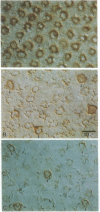Abstract
We previously have demonstrated that approximately 10% of cones in the fetal monkey retina precociously express the red/green opsin. These data suggested the possibility that a subset of cones differentiates prior to their nascent cone neighbors. To further assess this early cone differentiation in the fetal monkey retina, we used monoclonal antibodies proven to be important developmental markers of photoreceptor phenotypes and synaptogenesis (XAP-1, specific to photoreceptor membranes; SV2, specific to synaptic vesicle protein). Although these two antibodies recognize functionally distinct antigens, our analyses revealed that both identify a subset of precociously immunoreactive cones. Further, XAP-1- and SV2-positive cones are distributed in the same pattern as precocious red/green-sensitive cones in immature regions of the fetal monkey retina. These results support the hypothesis that the primate retina possesses a spatially organized protomap that may induce the emergence of the photoreceptor mosaic and trigger the formation of color-specific pathways that include horizontal, bipolar, and retinal ganglion cells.
Full text
PDF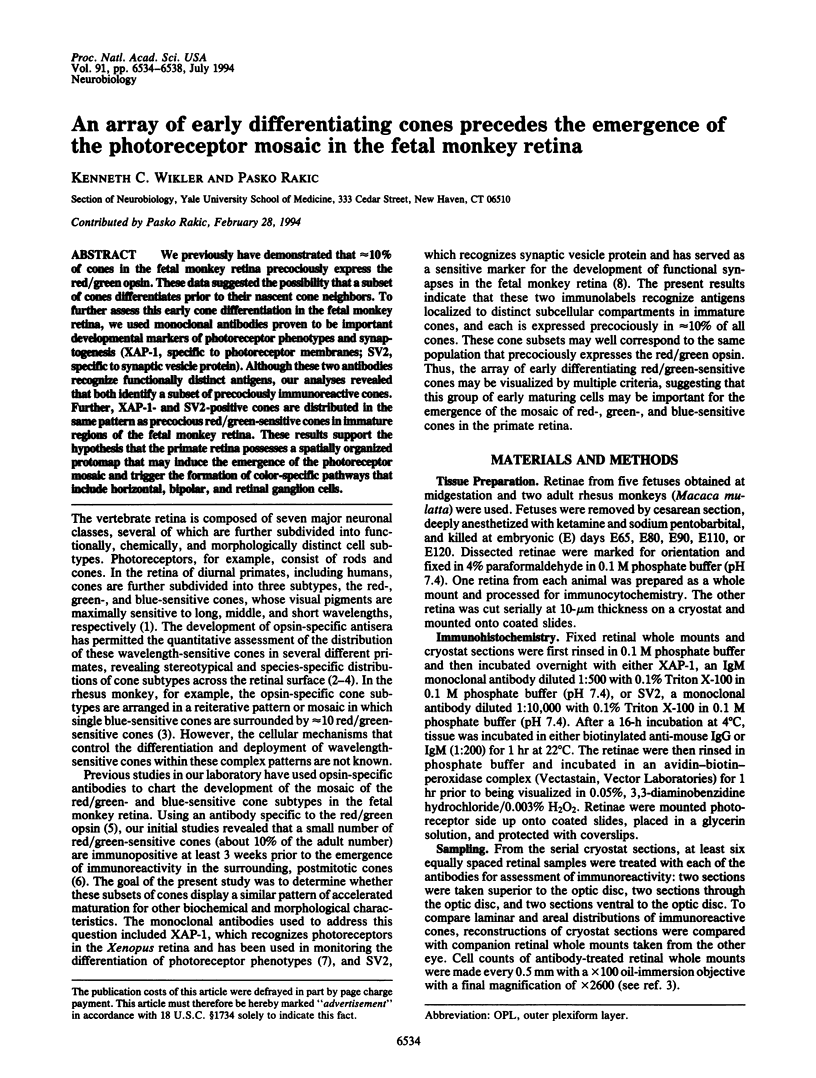
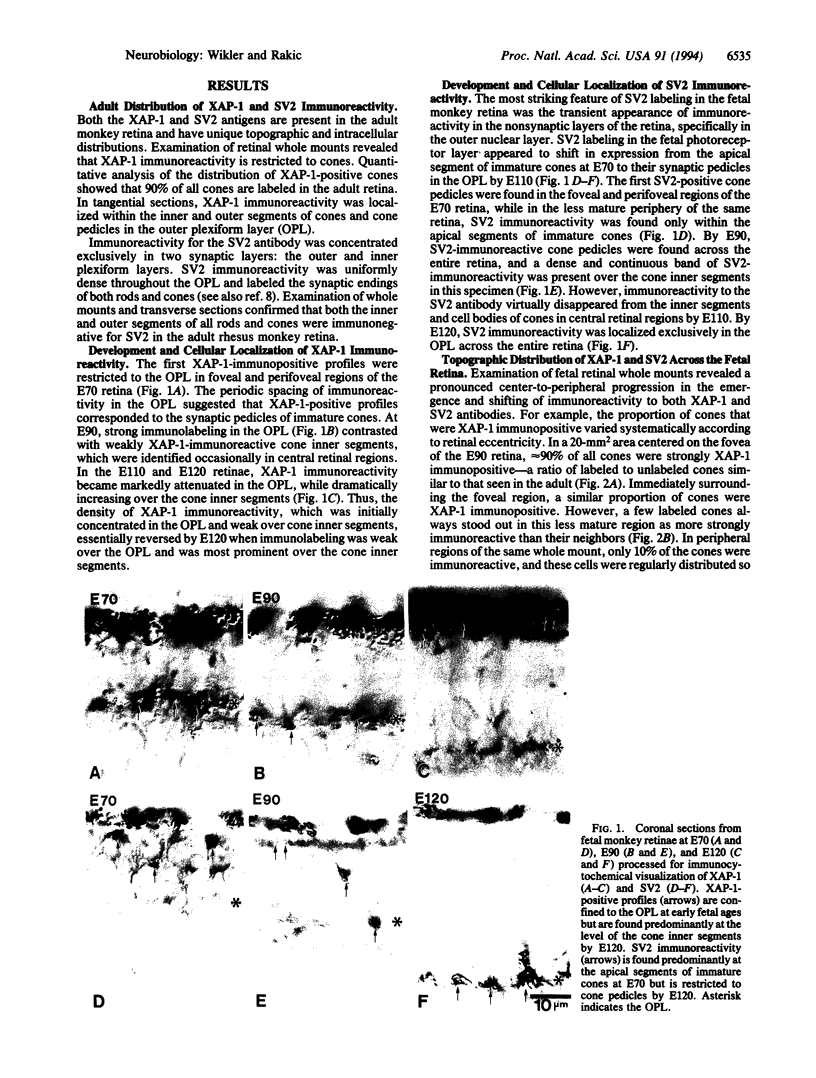
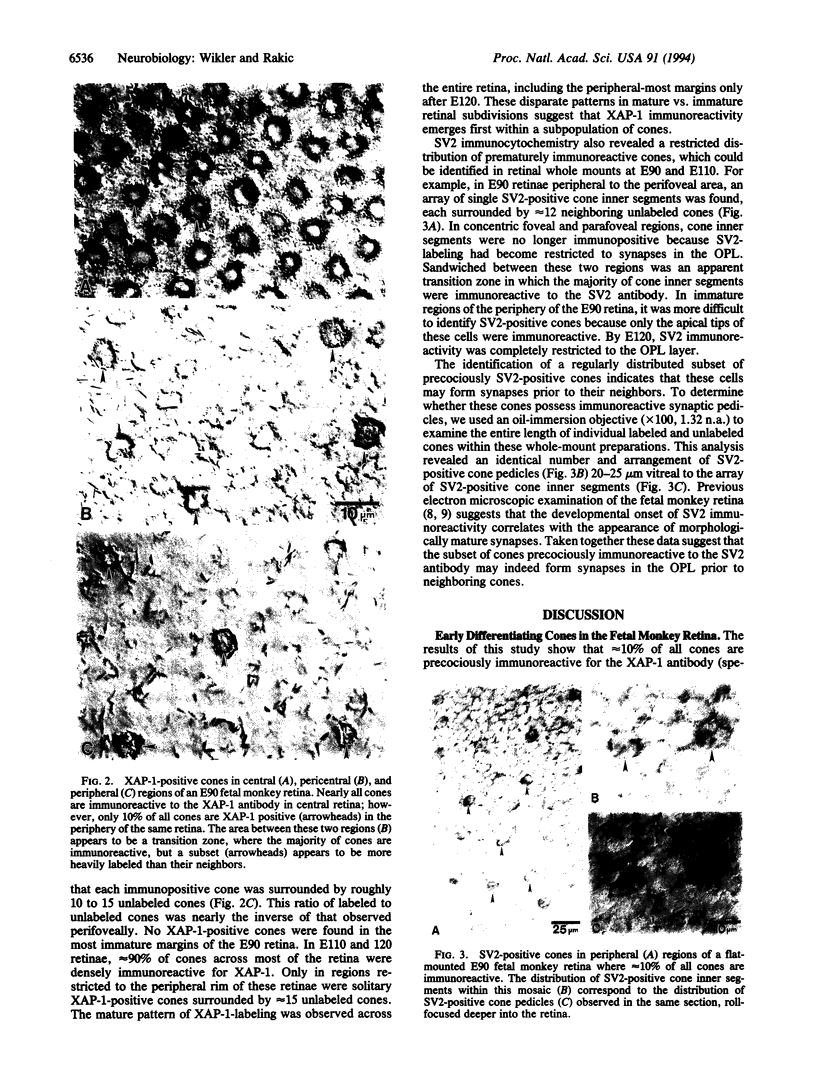
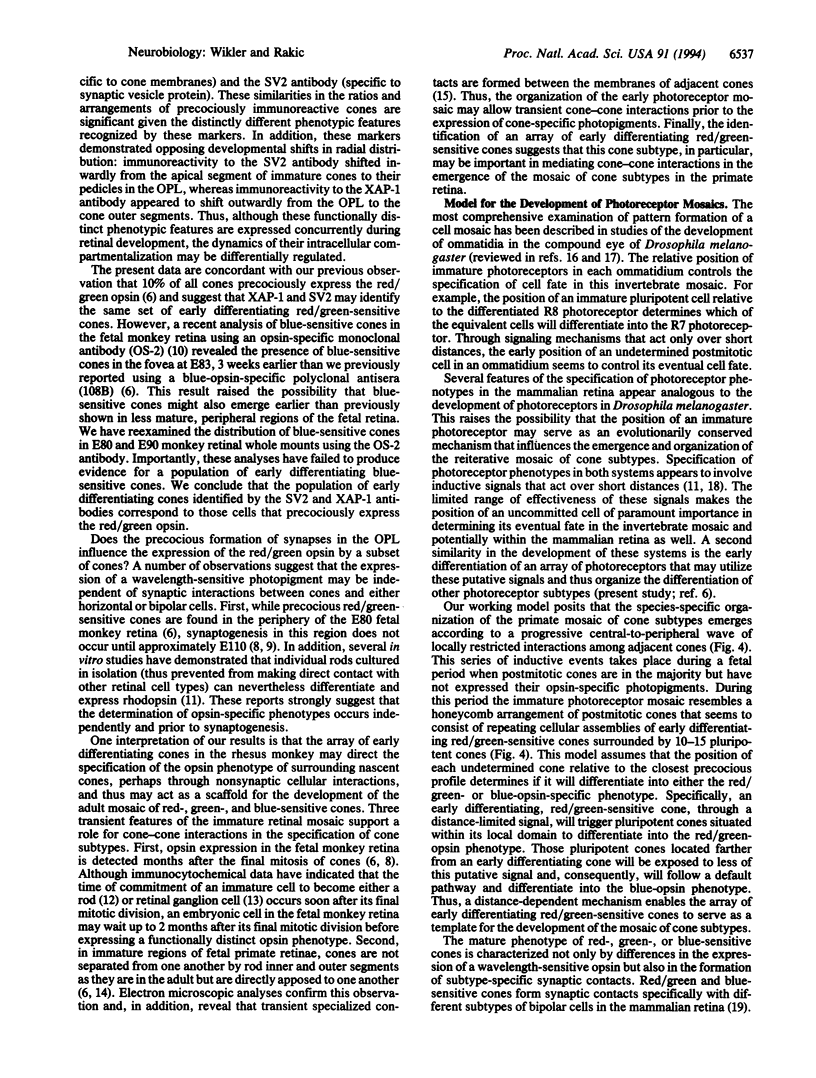
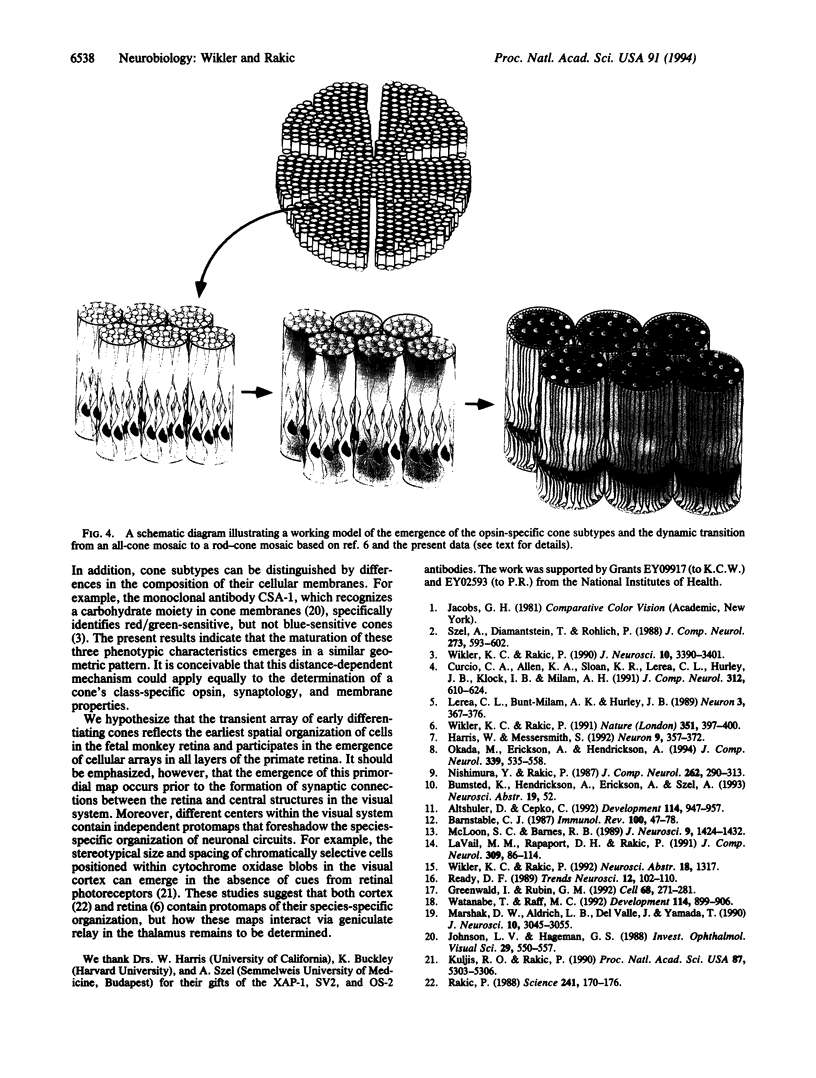
Images in this article
Selected References
These references are in PubMed. This may not be the complete list of references from this article.
- Altshuler D., Cepko C. A temporally regulated, diffusible activity is required for rod photoreceptor development in vitro. Development. 1992 Apr;114(4):947–957. doi: 10.1242/dev.114.4.947. [DOI] [PubMed] [Google Scholar]
- Barnstable C. J. Immunological studies of the diversity and development of the mammalian visual system. Immunol Rev. 1987 Dec;100:47–78. doi: 10.1111/j.1600-065x.1987.tb00527.x. [DOI] [PubMed] [Google Scholar]
- Curcio C. A., Allen K. A., Sloan K. R., Lerea C. L., Hurley J. B., Klock I. B., Milam A. H. Distribution and morphology of human cone photoreceptors stained with anti-blue opsin. J Comp Neurol. 1991 Oct 22;312(4):610–624. doi: 10.1002/cne.903120411. [DOI] [PubMed] [Google Scholar]
- Greenwald I., Rubin G. M. Making a difference: the role of cell-cell interactions in establishing separate identities for equivalent cells. Cell. 1992 Jan 24;68(2):271–281. doi: 10.1016/0092-8674(92)90470-w. [DOI] [PubMed] [Google Scholar]
- Harris W. A., Messersmith S. L. Two cellular inductions involved in photoreceptor determination in the Xenopus retina. Neuron. 1992 Aug;9(2):357–372. doi: 10.1016/0896-6273(92)90174-c. [DOI] [PubMed] [Google Scholar]
- Johnson L. V., Hageman G. S. Characterization of molecules bound by the cone photoreceptor-specific monoclonal antibody CSA-1. Invest Ophthalmol Vis Sci. 1988 Apr;29(4):550–557. [PubMed] [Google Scholar]
- Kuljis R. O., Rakic P. Hypercolumns in primate visual cortex can develop in the absence of cues from photoreceptors. Proc Natl Acad Sci U S A. 1990 Jul;87(14):5303–5306. doi: 10.1073/pnas.87.14.5303. [DOI] [PMC free article] [PubMed] [Google Scholar]
- La Vail M. M., Rapaport D. H., Rakic P. Cytogenesis in the monkey retina. J Comp Neurol. 1991 Jul 1;309(1):86–114. doi: 10.1002/cne.903090107. [DOI] [PubMed] [Google Scholar]
- Lerea C. L., Bunt-Milam A. H., Hurley J. B. Alpha transducin is present in blue-, green-, and red-sensitive cone photoreceptors in the human retina. Neuron. 1989 Sep;3(3):367–376. doi: 10.1016/0896-6273(89)90261-4. [DOI] [PubMed] [Google Scholar]
- Marshak D. W., Aldrich L. B., Del Valle J., Yamada T. Localization of immunoreactive cholecystokinin precursor to amacrine cells and bipolar cells of the macaque monkey retina. J Neurosci. 1990 Sep;10(9):3045–3055. doi: 10.1523/JNEUROSCI.10-09-03045.1990. [DOI] [PMC free article] [PubMed] [Google Scholar]
- McLoon S. C., Barnes R. B. Early differentiation of retinal ganglion cells: an axonal protein expressed by premigratory and migrating retinal ganglion cells. J Neurosci. 1989 Apr;9(4):1424–1432. doi: 10.1523/JNEUROSCI.09-04-01424.1989. [DOI] [PMC free article] [PubMed] [Google Scholar]
- Nishimura Y., Rakic P. Development of the rhesus monkey retina: II. A three-dimensional analysis of the sequences of synaptic combinations in the inner plexiform layer. J Comp Neurol. 1987 Aug 8;262(2):290–313. doi: 10.1002/cne.902620209. [DOI] [PubMed] [Google Scholar]
- Okada M., Erickson A., Hendrickson A. Light and electron microscopic analysis of synaptic development in Macaca monkey retina as detected by immunocytochemical labeling for the synaptic vesicle protein, SV2. J Comp Neurol. 1994 Jan 22;339(4):535–558. doi: 10.1002/cne.903390406. [DOI] [PubMed] [Google Scholar]
- Rakic P. Specification of cerebral cortical areas. Science. 1988 Jul 8;241(4862):170–176. doi: 10.1126/science.3291116. [DOI] [PubMed] [Google Scholar]
- Ready D. F. A multifaceted approach to neural development. Trends Neurosci. 1989 Mar;12(3):102–110. doi: 10.1016/0166-2236(89)90166-5. [DOI] [PubMed] [Google Scholar]
- Szél A., Diamantstein T., Röhlich P. Identification of the blue-sensitive cones in the mammalian retina by anti-visual pigment antibody. J Comp Neurol. 1988 Jul 22;273(4):593–602. doi: 10.1002/cne.902730413. [DOI] [PubMed] [Google Scholar]
- Watanabe T., Raff M. C. Diffusible rod-promoting signals in the developing rat retina. Development. 1992 Apr;114(4):899–906. doi: 10.1242/dev.114.4.899. [DOI] [PubMed] [Google Scholar]
- Wikler K. C., Rakic P. Distribution of photoreceptor subtypes in the retina of diurnal and nocturnal primates. J Neurosci. 1990 Oct;10(10):3390–3401. doi: 10.1523/JNEUROSCI.10-10-03390.1990. [DOI] [PMC free article] [PubMed] [Google Scholar]
- Wikler K. C., Rakic P. Relation of an array of early-differentiating cones to the photoreceptor mosaic in the primate retina. Nature. 1991 May 30;351(6325):397–400. doi: 10.1038/351397a0. [DOI] [PubMed] [Google Scholar]




